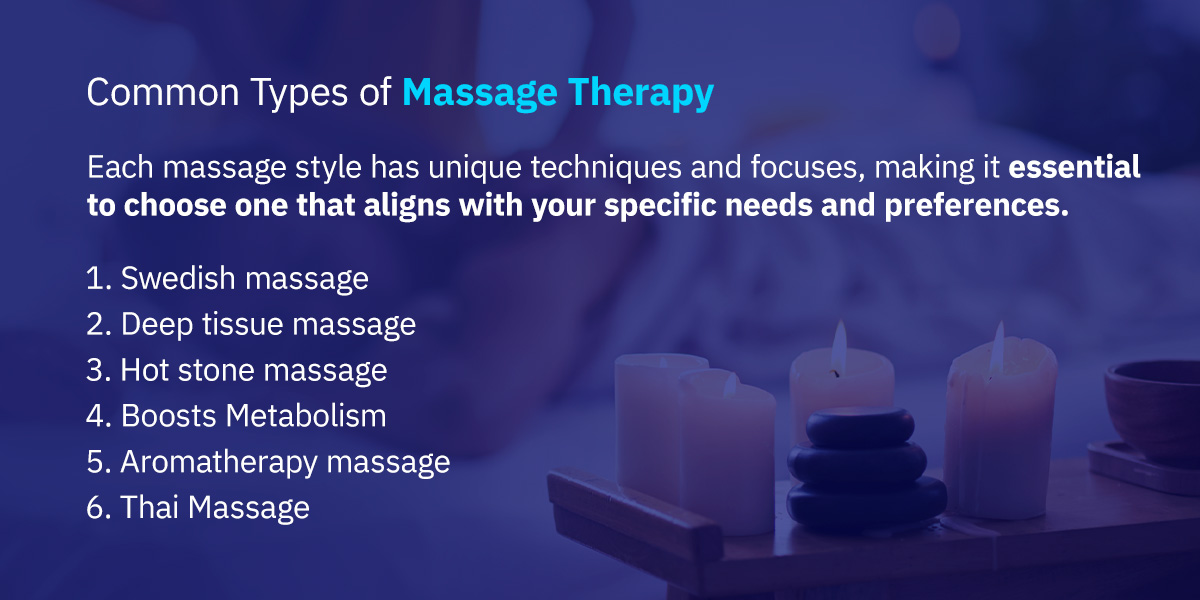Massage Therapy Guide
Massage Therapy Guide
Posted on: October 18, 2023 in Massage
Imagine a soothing, expertly administered touch that relaxes your body and rejuvenates your spirit. That is the essence of massage therapy. The power of massage has been used for centuries to promote healing, relaxation and overall wellness.
Whether you seek relief from pain, stress reduction or simply a moment of blissful relaxation, massage therapy offers a solution. In the following guide, we’ll explore different types of massages to help you make the most of your massage therapy experience.
What Is Massage Therapy?
Massage therapy is an ancient healing practice that combines the art of touch with scientific knowledge to promote relaxation, alleviate pain and enhance overall health. Rooted in traditions dating back thousands of years, it has evolved into a respected and widely recognized form of complementary medicine.
A massage involves the skilled manipulation of soft tissues like muscles, tendons, ligaments and fascia. Therapeutic techniques deployed by a massage therapist address physical and emotional concerns, from stress and tension to chronic pain and injury recovery.
Benefits of Massage Therapy
The healing touch of massage therapy provides a remarkable avenue to prioritize your well-being. Here are the benefits that await when you embrace massage therapy as part of your self-care routine:
- Stress reduction and relaxation: Massage therapy triggers the release of endorphins, your body’s natural mood enhancers, and reduces the production of stress hormones like cortisol. The result? Profound relaxation and a renewed sense of calm.
- Pain management and relief: Are chronic aches and pains holding you back from enjoying life to the fullest? Massage therapy can be a powerful ally in your journey to pain relief. Skilled therapists can target specific areas of discomfort, using techniques like deep tissue or trigger point therapy to alleviate tension and reduce pain.
- Enhanced flexibility and range of motion: Massage therapy promotes joint lubrication, stretching and muscle relaxation, which, over time, can significantly improve your flexibility and range of motion.
- Improved circulation: A healthy circulatory system delivers oxygen and nutrients to your body’s cells. Massage therapy enhances blood flow, allowing for better circulation throughout your body.
- Boosted immune function: Believe it or not, regular massages may bolster your immune system. Studies have shown that massage therapy can increase the production of white blood cells, which help fight viruses.
- Mental health and emotional well-being: Massage therapy provides a safe space to disconnect from the pressures of daily life, reduce anxiety and depression, and enhance your overall mood.
- Better sleep quality: Struggling with sleepless nights? Massage therapy can be a natural solution. The relaxation it induces can help you achieve deeper and more restorative sleep.
- Holistic well-being: One of massage therapy’s most profound aspects is its holistic approach to health. It recognizes that our physical, emotional and spiritual selves are interconnected.
Common Types of Massage Therapy
Now that you’re well-acquainted with massage therapy’s numerous benefits, let’s look at the different types of massages available. Each massage style has unique techniques and focuses, making it essential to choose one that aligns with your specific needs and preferences.

- Swedish massage: A Swedish massage is an excellent starting point if you’re new to massages or seeking pure relaxation. This classic style is characterized by long strokes, as well as kneading and tapping.
- Deep tissue massage: This massage goes beyond the surface to target deeper muscles and layers of connective tissue. Therapists use firm pressure and slow strokes to help alleviate chronic muscle tension and address injuries and postural issues. It can be slightly intense but effectively relieves chronic pain and muscular knots.
- Hot stone massage: Hot stone massage involves using heated stones placed on specific areas of your body or used by the therapist as an extension of their hands. The warmth of the stones enhances relaxation and helps to loosen tight muscles. It’s an excellent choice for those seeking a luxurious and deeply soothing experience.
- Aromatherapy massage: Your therapist will select oils tailored to your needs, such as lavender for relaxation or eucalyptus for invigoration. The aroma adds an extra dimension of relaxation to your massage session.
- Thai Massage: Thai massage combines acupressure, assisted stretching and poses similar to yoga. It’s performed on a mat on the floor, and the therapist uses their hands, elbows, knees and feet to apply pressure and guide you through stretches.
Somatic Healing Massage
Somatic healing massage therapy is a specialized form of bodywork that integrates principles from somatic therapy. This therapy goes beyond physical touch to address the profound connection between the body and the mind, aiming to restore balance and harmony in both.
Somatic healing massage therapy is typically performed by trained and certified somatic therapists who deeply understand the mind-body connection. Sessions are often tailored to the individual’s needs and may include elements of talk therapy, movement and touch.
Principles of somatic healing massage therapy include:
- Mind-body connection: Central to somatic healing is the recognition that emotional and psychological experiences can manifest as physical tension and discomfort in the body. The therapists understand that past traumas, stress and unresolved emotions can become stored in the muscles and tissues, leading to pain and dysfunction.
- Awareness and mindfulness: Somatic healing encourages clients to become more aware of their body’s sensations, movements and patterns.
- Gentle exploration: Unlike other massage techniques that use deep pressure and vigorous movements, somatic healing often employs gentle touches and slow, deliberate strokes. This allows clients to feel more connected to their bodies and facilitates the release of tension.
- Breathwork: Therapists guide clients in using their breath to deepen relaxation, release tension and promote emotional release.
Why Massage Therapy Certification Matters
Certification serves as an indicator of a therapist’s competence, professionalism and commitment to ethical practices.
Assurance of Competence
Certification in massage therapy demonstrates that a practitioner has met the minimum educational and training requirements established by a reputable certifying body or organization. This assurance of competence means that the therapist has undergone formal training, understands anatomy and physiology, and has mastered various massage techniques.
Ethical and Professional Standards
Certified massage therapists are bound by a code of ethics and professional standards set forth by their certifying organizations. These standards encompass client confidentiality, appropriate boundaries, informed consent, and maintaining a safe and hygienic practice environment.
Safety and Risk Mitigation
Certification requires therapists to understand contraindications, conditions or situations where massage may be harmful. Certified practitioners who recognize these contraindications will adjust their treatments accordingly, reducing the risk of injury or harm to the client.
Access to Insurance Coverage
Certified massage therapists may be eligible for professional liability insurance coverage. This insurance protects the therapist and provides peace of mind to clients, knowing that there is recourse in the unlikely event of any adverse incidents during a session.
Is Massage Therapy Covered by Insurance?
The coverage for massage therapy can vary depending on several factors, including your insurance provider, the specific policy you hold and the reason for seeking massage therapy. Certain insurance plans, especially those focused on holistic health and wellness, may include coverage for alternative or complementary therapies, such as acupuncture, chiropractic care and massage therapy. If your insurance plan falls into this category, there’s a higher likelihood of obtaining coverage for massage therapy.
Before seeking massage therapy with the hope of insurance reimbursement, contact your insurance provider and inquire about their specific policies and requirements. Some insurers may require preauthorization, documentation from a health care provider or specific diagnostic codes to process claims.
Massage Therapy at 5 Bridges Health & Fitness
At 5 Bridges Health & Fitness, you can book a massage therapy appointment with Shani, our resident Self-Care Specialist and Licensed Massage Therapist. Our massage therapy method combines the principles of somatic therapy with the art of massage, offering an approach that addresses physical ailments as well as the emotional and psychological aspects of your health.
Learn more about massage therapy at 5 Bridges Health & Fitness today!



